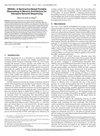Pyramid: Accelerating LLM Inference With Cross-Level Processing-in-Memory
IF 1.4
3区 计算机科学
Q4 COMPUTER SCIENCE, HARDWARE & ARCHITECTURE
引用次数: 0
Abstract
Integrating processing-in-memory (PIM) with GPUs accelerates large language model (LLM) inference, but existing GPU-PIM systems encounter several challenges. While GPUs excel in large general matrix-matrix multiplications (GEMM), they struggle with small-scale operations better suited for PIM, which currently cannot handle them independently. Additionally, the computational demands of activation operations exceed the capabilities of current PIM technologies, leading to excessive data movement between the GPU and memory. PIM's potential for general matrix-vector multiplications (GEMV) is also limited by insufficient support for fine-grained parallelism. To address these issues, we propose Pyramid, a novel GPU-PIM system that optimizes PIM for LLM inference by strategically allocating cross-level computational resources within PIM to meet diverse needs and leveraging the strengths of both technologies. Evaluation results demonstrate that Pyramid outperforms existing systems like NeuPIM, AiM, and AttAcc by factors of 2.31×,金字塔:用内存中的跨层处理加速LLM推理
将内存处理(PIM)与gpu集成可以加速大语言模型(LLM)推理,但现有的GPU-PIM系统面临一些挑战。虽然gpu在大型一般矩阵-矩阵乘法(GEMM)中表现出色,但它们在更适合PIM的小规模操作中挣扎,PIM目前无法独立处理它们。此外,激活操作的计算需求超出了当前PIM技术的能力,导致GPU和内存之间的数据移动过多。PIM对一般矩阵向量乘法(GEMV)的潜力也受到对细粒度并行性支持不足的限制。为了解决这些问题,我们提出了一种新的GPU-PIM系统Pyramid,该系统通过在PIM内战略性地分配跨层计算资源来优化PIM的LLM推理,以满足不同的需求并利用两种技术的优势。评估结果表明,Pyramid比现有系统如NeuPIM、AiM和AttAcc分别高出2.31倍、1.91倍和1.72倍。
本文章由计算机程序翻译,如有差异,请以英文原文为准。
求助全文
约1分钟内获得全文
求助全文
来源期刊

IEEE Computer Architecture Letters
COMPUTER SCIENCE, HARDWARE & ARCHITECTURE-
CiteScore
4.60
自引率
4.30%
发文量
29
期刊介绍:
IEEE Computer Architecture Letters is a rigorously peer-reviewed forum for publishing early, high-impact results in the areas of uni- and multiprocessor computer systems, computer architecture, microarchitecture, workload characterization, performance evaluation and simulation techniques, and power-aware computing. Submissions are welcomed on any topic in computer architecture, especially but not limited to: microprocessor and multiprocessor systems, microarchitecture and ILP processors, workload characterization, performance evaluation and simulation techniques, compiler-hardware and operating system-hardware interactions, interconnect architectures, memory and cache systems, power and thermal issues at the architecture level, I/O architectures and techniques, independent validation of previously published results, analysis of unsuccessful techniques, domain-specific processor architectures (e.g., embedded, graphics, network, etc.), real-time and high-availability architectures, reconfigurable systems.
 求助内容:
求助内容: 应助结果提醒方式:
应助结果提醒方式:


